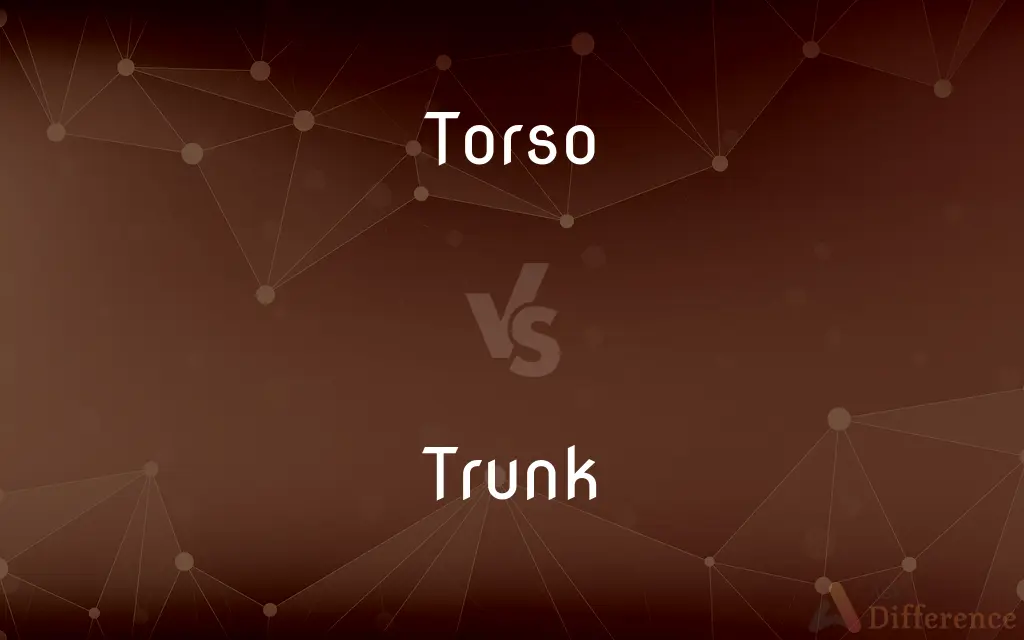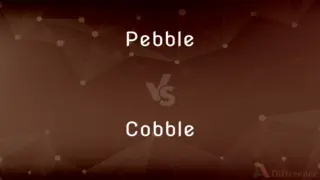Torso vs. Trunk — What's the Difference?
By Tayyaba Rehman & Maham Liaqat — Updated on April 9, 2024
The torso refers to the central part of the human body, excluding the limbs and head, while the trunk typically means the same but is also used for the main body of other objects.

Difference Between Torso and Trunk
Table of Contents
ADVERTISEMENT
Key Differences
The torso is a term specifically used in human anatomy to describe the central part of the body, encompassing the chest, abdomen, and back, but excluding the head, neck, arms, and legs. On the other hand, the trunk is more versatile, referring not only to a similar area in humans but also to the main body of trees and other objects, like the trunk of an elephant or a car.
In the context of human anatomy, both terms are often used interchangeably to refer to the body's central part. However, "torso" is more commonly used in a medical or artistic context, highlighting the anatomical and aesthetic aspects of the human body. Conversely, "trunk" can convey a broader range of meanings, emphasizing the core structure or main part of various objects or beings.
The term "torso" is derived from the Italian word "torso," meaning "stump" or "trunk of a statue," indicating its focus on the human body's form and structure. In contrast, "trunk" originates from the Latin "truncus," meaning "mutilated" or "cut off," which can apply to the central part of anything that extends outward, such as tree trunks or the main storage compartment in vehicles.
Despite their similarities, the choice between "torso" and "trunk" can depend on the context. In detailed discussions of human anatomy or in the arts, "torso" is preferred for its specificity and cultural connotations. Meanwhile, "trunk" is selected for its versatility and broad applicability across different contexts, from biology to everyday language.
Comparison Chart
Definition
The central part of the human body excluding limbs and head.
The main body of an object, person, or animal.
ADVERTISEMENT
Usage Context
Human anatomy, medicine, art.
General, including anatomy, objects, and nature.
Derivation
From Italian "torso," meaning "stump" or "trunk of a statue."
From Latin "truncus," meaning "mutilated" or "cut off."
Specificity
Specific to human anatomy.
Broad, applicable to various objects and beings.
Associated With
Artistic and medical descriptions of the human body.
Objects like cars, trees, animals, and anatomical descriptions.
Compare with Definitions
Torso
The torso includes the chest, abdomen, and back.
The torso is essential in human anatomy studies.
Trunk
In vehicles, the trunk is the primary storage area.
Luggage is stored in the car's trunk.
Torso
Artists often study the torso for its form and structure.
Sculptors pay special attention to the torso in their works.
Trunk
Used in various contexts beyond anatomy.
The trunk is a versatile term across disciplines.
Torso
Medical professionals examine the torso for various health assessments.
The torso is checked during a physical examination.
Trunk
Refers to the main body of humans, trees, and objects.
The trunk of a tree is its main support structure.
Torso
The torso is a central focus in anatomical studies.
Anatomy classes often start with the torso's structure.
Trunk
Elephants are known for their long trunks.
An elephant uses its trunk to grasp objects.
Torso
The torso houses vital organs needing protection.
The ribcage in the torso protects the heart and lungs.
Trunk
Emphasizes the main, central part of something.
The trunk supports the tree's entire weight.
Torso
The torso or trunk is an anatomical term for the central part, or core, of many animal bodies (including humans) from which extend the neck and limbs. The torso includes: the thoracic segment of the trunk, the abdominal segment of the trunk, and the perineum.
Trunk
The main woody stem of a tree as distinct from its branches and roots.
Torso
The human body excluding the head and limbs; trunk.
Trunk
A person's or animal's body apart from the limbs and head.
Torso
A statue of the human body with the head and limbs omitted or removed.
Trunk
The elongated, prehensile nose of an elephant.
Torso
A truncated or unfinished thing.
Trunk
A large box with a hinged lid for storing or transporting clothes and other articles.
Torso
The main part of the (human) body that extends from the neck to the groin, excluding the head and limbs.
Trunk
The main woody axis of a tree.
Torso
The human body, as distinguished from the head and limbs; in sculpture, the trunk of a statue, mutilated of head and limbs; as, the torso of Hercules.
Trunk
(Architecture) The shaft of a column.
Torso
The body excluding the head and neck and limbs;
They moved their arms and legs and bodies
Trunk
The body of a human or other vertebrate, excluding the head and limbs.
Trunk
The thorax of an insect.
Trunk
A proboscis, especially the long prehensile proboscis of an elephant.
Trunk
A main body, apart from tributaries or appendages.
Trunk
The main stem of a blood vessel or nerve apart from the branches.
Trunk
A trunk line.
Trunk
A chute or conduit.
Trunk
A watertight shaft connecting two or more decks.
Trunk
The housing for the centerboard of a vessel.
Trunk
A covering over the hatches of a ship.
Trunk
An expansion chamber on a tanker.
Trunk
A cabin on a small boat.
Trunk
A covered compartment for luggage and storage, generally at the rear of an automobile.
Trunk
A large packing case or box that clasps shut, used as luggage or for storage.
Trunk
Trunks Shorts worn for swimming or other athletics.
Trunk
Part of a body.
Trunk
The usually single, more or less upright part of a tree, between the roots and the branches.
Trunk
The torso.
Trunk
The conspicuously extended, mobile, nose-like organ of an animal such as a sengi, a tapir or especially an elephant. The trunks of various kinds of animals might be adapted to probing and sniffing, as in the sengis, or be partly prehensile, as in the tapir, or be a versatile prehensile organ for manipulation, feeding, drinking and fighting as in the elephant.
Trunk
(heading) A container.
Trunk
A large suitcase, chest, or similar receptacle for carrying or storing personal possessions, usually with a hinged, often domed lid, and handles at each end, so that generally it takes two persons to carry a full trunk.
Trunk
A box or chest usually covered with leather, metal, or cloth, or sometimes made of leather, hide, or metal, for holding or transporting clothes or other goods.
Trunk
The luggage storage compartment of a sedan/saloon-style car.
Trunk
(automotive) A storage compartment fitted behind the seat of a motorcycle.
Trunk
(heading) A channel for flow of some kind.
Trunk
A circuit between telephone switchboards or other switching equipment.
Trunk
A chute or conduit, or a watertight shaft connecting two or more decks.
Trunk
A long, large box, pipe, or conductor, made of plank or metal plates, for various uses, as for conveying air to a mine or to a furnace, water to a mill, grain to an elevator, etc.
Trunk
(archaic) A long tube through which pellets of clay, peas, etc., are driven by the force of the breath. A peashooter
Trunk
(mining) A flume or sluice in which ores are separated from the slimes in which they are contained.
Trunk
(software engineering) In software projects under source control: the most current source tree, from which the latest unstable builds (so-called "trunk builds") are compiled.
Trunk
The main line or body of anything.
The trunk of a vein or of an artery, as distinct from the branches
Trunk
(transport) A main line in a river, canal, railroad, or highway system.
Trunk
(architecture) The part of a pilaster between the base and capital, corresponding to the shaft of a column.
Trunk
A large pipe forming the piston rod of a steam engine, of sufficient diameter to allow one end of the connecting rod to be attached to the crank, and the other end to pass within the pipe directly to the piston, thus making the engine more compact.
Trunk
(in the plural) swimming trunks
Trunk
To lop off; to curtail; to truncate.
Trunk
To extract (ores) from the slimes in which they are contained, by means of a trunk.
Trunk
(telecommunication) To provide simultaneous network access to multiple clients by sharing a set of circuits, carriers, channels, or frequencies.
Trunk
The stem, or body, of a tree, apart from its limbs and roots; the main stem, without the branches; stock; stalk.
About the mossy trunk I wound me soon,For, high from ground, the branches would requireThy utmost reach.
Trunk
The body of an animal, apart from the head and limbs.
Trunk
The main body of anything; as, the trunk of a vein or of an artery, as distinct from the branches.
Trunk
That part of a pilaster which is between the base and the capital, corresponding to the shaft of a column.
Trunk
That segment of the body of an insect which is between the head and abdomen, and bears the wings and legs; the thorax; the truncus.
Trunk
The proboscis of an elephant.
Trunk
A long tube through which pellets of clay, p as, etc., are driven by the force of the breath.
He shot sugarplums them out of a trunk.
Trunk
A box or chest usually covered with leather, metal, or cloth, or sometimes made of leather, hide, or metal, for containing clothes or other goods; especially, one used to convey the effects of a traveler.
Locked up in chests and trunks.
Trunk
A flume or sluice in which ores are separated from the slimes in which they are contained.
Trunk
A large pipe forming the piston rod of a steam engine, of sufficient diameter to allow one end of the connecting rod to be attached to the crank, and the other end to pass within the pipe directly to the piston, thus making the engine more compact.
Trunk
A long, large box, pipe, or conductor, made of plank or metal plates, for various uses, as for conveying air to a mine or to a furnace, water to a mill, grain to an elevator, etc.
Trunk
To lop off; to curtail; to truncate; to maim.
Trunk
The main stem of a tree; usually covered with bark; the bole is usually the part that is commercially useful for lumber
Trunk
Luggage consisting of a large strong case used when traveling or for storage
Trunk
The body excluding the head and neck and limbs;
They moved their arms and legs and bodies
Trunk
Compartment in an automobile that carries luggage or shopping or tools;
He put his golf bag in the trunk
Trunk
A long flexible snout as of an elephant
Common Curiosities
Why is the torso important in art?
The torso is crucial in art for studying human form and structure.
How are torso and trunk similar?
Both terms can describe the main body part of humans, but "trunk" has broader applications.
What is the origin of the term 'torso'?
"Torso" originates from Italian, meaning "stump" or "trunk of a statue," focusing on human form.
What does the torso include?
The torso includes the central part of the human body, such as the chest, abdomen, and back, excluding limbs and head.
What distinguishes the torso from the trunk in usage?
"Torso" is more specific to human anatomy, while "trunk" is versatile, applying to various objects and beings.
Can the term 'trunk' apply to animal anatomy?
Yes, in animals like elephants, the trunk refers to their long, flexible nose.
How is the torso relevant in anatomical studies?
The torso is a central focus due to its structure and the vital organs it houses.
What can the term 'trunk' refer to?
"Trunk" can refer to the main body of humans, trees, objects like cars, and animals such as elephants.
How is the term 'trunk' used in the context of storage?
In cars, the trunk refers to the rear storage area for luggage.
What does the torso protect in the human body?
The torso protects vital organs, such as the heart and lungs, within the ribcage.
How does the medical field use the term 'torso'?
In medicine, the torso is examined for health assessments and physical examinations.
What is the significance of the trunk in vehicles?
The trunk in vehicles serves as the main storage compartment.
What role does the trunk play in trees?
The trunk acts as the main support structure and nutrient conduit in trees.
Why might an artist study the torso?
Artists study the torso for its aesthetic and structural aspects, crucial for sculpting and drawing.
What is the origin of the term 'trunk'?
"Trunk" comes from Latin "truncus," meaning "mutilated" or "cut off," and applies broadly.
Share Your Discovery

Previous Comparison
Pebble vs. Cobble
Next Comparison
Journalist vs. ColumnistAuthor Spotlight
Written by
Tayyaba RehmanTayyaba Rehman is a distinguished writer, currently serving as a primary contributor to askdifference.com. As a researcher in semantics and etymology, Tayyaba's passion for the complexity of languages and their distinctions has found a perfect home on the platform. Tayyaba delves into the intricacies of language, distinguishing between commonly confused words and phrases, thereby providing clarity for readers worldwide.
Co-written by
Maham Liaqat















































